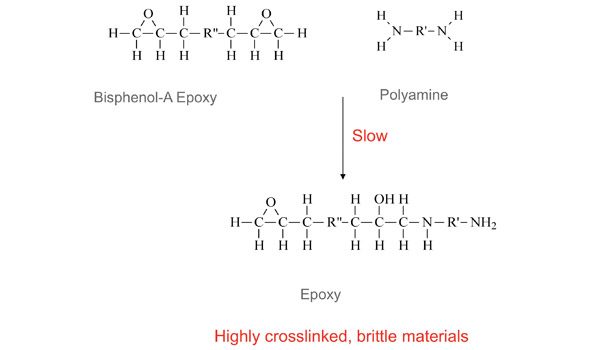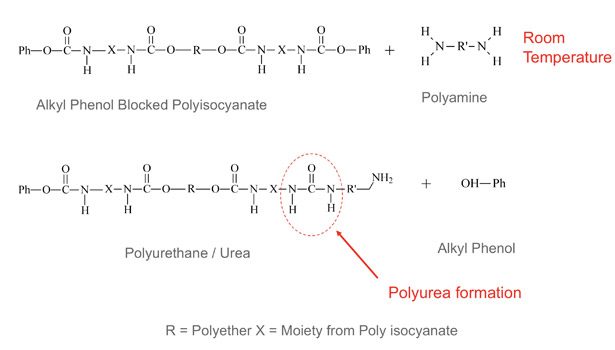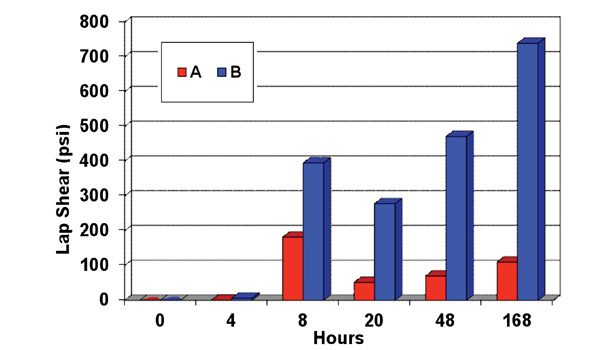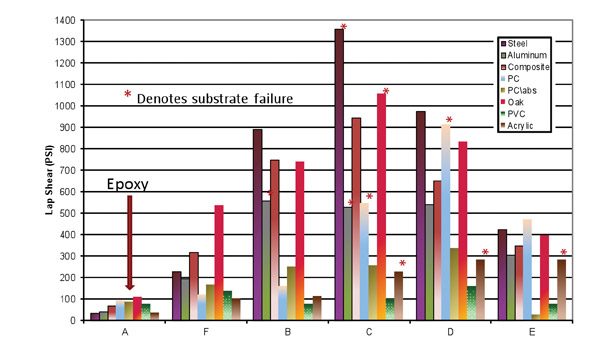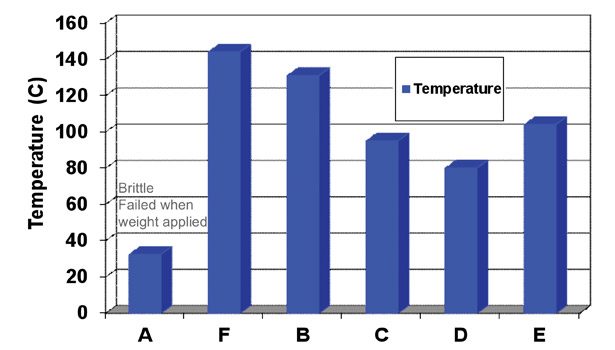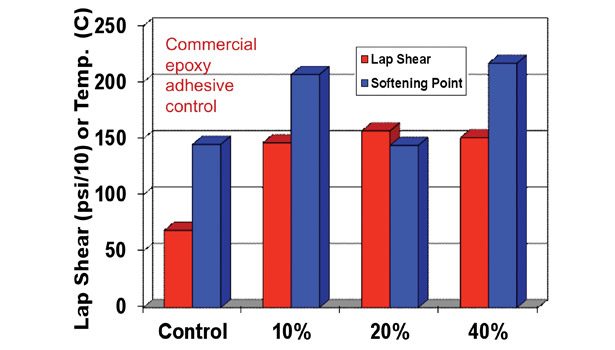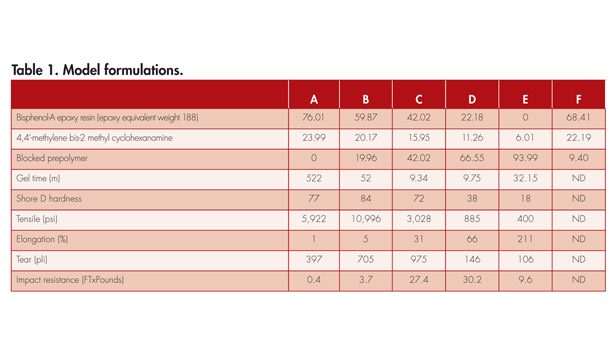Due to their different physical properties, epoxy adhesives and polyurethane adhesives are sold into different segments of the adhesives market. Epoxy adhesives are targeted for applications requiring rigidity, solvent resistance and ultra-high-temperature resistance. Polyurethane adhesives are targeted for applications requiring toughness, processing flexibility, tunable cure rates, low-temperature cure and adhesion to many different substrates.
While the hybridization of epoxy and polyurethane technology is not a new concept for coating applications, the hybridization of adhesives is not as common. Commercial epoxy adhesives face several challenges that can be remedied by hybridizing these two technologies. The most important improvement to epoxies is a reduction in brittleness, which comes from the inherently high crosslink density of epoxy chemistry.
Epoxy Strengthening Methods
Adhesive formulators use several strategies to minimize brittleness in epoxy formulations. Most of these strategies involve the creation of a second phase in the epoxy matrix that interrupts crack propagation through the brittle epoxy matrix. Other strategies to reduce brittleness involve the addition of reactive diluents or plasticizers to the epoxy resin.
In phase-separated, toughened epoxies, the second phase has some technical requirements. The second phase must be incompatible with the epoxy matrix and must phase-separate uniformly during cure. It is also preferred that the second phase be reactive with epoxy resins so that the hard epoxy phase and the second phase are covalently bonded. In addition, the phases should be compatible until polymerization. This allows the resins to be stored before use without separating into layers. If the resins separate during storage, additional mixing may be required before application. The second phase may be formed from thermoplastic resins, high-molecular-weight flexible polyether amine resins, rubber particles, core-shell rubber particles, dispersed acrylic rubbers, and amine-terminated butadiene acrylonitrile resins.
Another strategy for toughening epoxies is to react a polyurethane segment into an epoxy polymer. This chemistry has been around for many years and has been used commercially in the coatings industry.1 Epoxy coatings modified with a polyurethane segment exhibit reduced brittleness, increased substrate adhesion and improved impact resistance.
Recently, the addition of a polyurethane segment into an epoxy adhesive has been tested. The addition of a polyurethane segment gives unexpected improvements in adhesion and temperature resistance. The incorporation of a polyurethane segment into an epoxy adhesive is accomplished by means of a blocked polyurethane prepolymer.
Epoxy Chemistry
Epoxy reactions are characterized as the reaction of an epoxy resin and a curing agent (sometimes called a hardener). The epoxy functional resin is typically multifunctional and can vary in molecular weight. The reactive moiety is a three-member carbon-carbon-oxygen ring.
Curing agents typically possess an active hydrogen. Typical curing agents include amines, alcohols or carboxylic acids. In many two-component adhesives, the epoxy reaction occurs between an epoxy ring and an amine (see Figure 1). The driving force for this reaction is the release of strain of the three-member ring.
Each primary amine can react with two epoxy rings, so a diamine with two primary amines actually has a functionality of four. This high functionality leads to highly crosslinked polymers.
Blocked Polyurethane Prepolymers
Polyurethane prepolymers blocked with phenolic compounds have been commercially available for many years. These prepolymers will unblock at room temperature in the presence of a strong amine (see Figure 2). Unlike stoving compounds, no addition of heat is required to unblock the prepolymer. One blocked group will react with one primary amine. This leads to linear or low-crosslink-density polymers.
Increasing levels of a blocked polyurethane prepolymer were added to a commercially available epoxy resin to demonstrate the prepolymer’s effects on physical properties. The epoxy resin was first mixed with the blocked prepolymer, and the subsequent blend was reacted with an amine. The formulations appear in Table 1.
The gel time and the physical properties of the cured blends were measured and entered into Table 1. The gel time decreases with increasing levels of blocked prepolymer. As the level of blocked prepolymer increases, the level of released phenolic compound also increases. Phenolic compounds are known to act as catalysts for the epoxy reaction. It is postulated that the phenolic compound catalyzes the epoxy reaction and decreases the gel time.
Tensile strength initially increases with increasing levels of blocked prepolymer. This is most likely the result of Formulation A vitrifying before polymerization is complete. The incorporation of the blocked polyurethane prepolymer in Formulation B allows polymerization to complete before vitrification occurs. As additional blocked prepolymer is added to the formulation, strength falls as the hard block content of the polymer decreases.
As expected, tear resistance increases in Formulations B and C with increasing levels of blocked prepolymer. Tear resistance decreases in Formulations D and E as hard block content decreases.
Strength Development
The development of lap shear strength over time was determined for the all-epoxy model compound and for Formulation B (20% level of the blocked polyurethane prepolymer; see Figure 3). Lap shear strength begins to build for Formulation B (the sample containing the polyurethane prepolymer) at four hours. At eight hours, a significant difference in lap shear strength is evident. Lap shear strength falls for the all-epoxy adhesive between eight and 24 hours as the adhesive becomes more brittle.
The lap shear strength of the six formulations was measured on eight different substrates. Formulation A, the all-epoxy formulation, was brittle and had a low lap shear strength. The addition of the blocked polyurethane prepolymer increased the adhesive strength of the epoxy. As expected, adhesive strength fell at the highest level of polyurethane modification due to the low hard block content of the adhesive.
Softening Point Determination
Heat resistances of the adhesive formulations were determined by a standard softening point experiment. Surprisingly, the addition of a small amount of block prepolymer increased the softening point of the adhesive (see Figure 5). It is postulated that the all-epoxy adhesive vitrified before full polymerization, and that the resulting brittle adhesive failed when stress was applied to it.
Testing Modified Adhesives
Testing with commercial adhesives was undertaken to determine if the addition of a blocked polyurethane prepolymer could improve the performance of a commercial epoxy adhesive. A commercial epoxy adhesive was purchased at a home improvement warehouse. An appropriate amount of blocked polyurethane prepolymer and a stoichiometrically adjusted amount of diamine were added to the adhesive.
The lap shear strength of this adhesive was measured on steel, and the softening point temperature was measured on canvas. The addition of 20% blocked polyurethane prepolymer increased the lap shear strength of the adhesive to over 1,400 psi. Surprisingly, the softening point of the epoxy adhesive increased with the addition of blocked prepolymer, which goes against conventional wisdom. Epoxy adhesives are typically used in high-temperature applications.
To confirm the results of the previous testing, a commercial epoxy adhesive from a different manufacturer was tested. The epoxy adhesive was purchased at a hardware store. Once again, blocked polyurethane prepolymer and a stoichiometric amount of diamine were added to the epoxy adhesive. With this adhesive, the lap shear strength increased to approximately 1,500 psi following the addition of blocked polyurethane prepolymer. The softening point data indicated that the addition of the blocked polyurethane prepolymer improved heat resistance at two of the three levels tested.
Performance Improvements
The properties of commercial epoxy adhesives can be improved through the addition of a blocked polyurethane prepolymer. The blocked polyurethane prepolymer improves an epoxy adhesive’s performance in three ways.
First, the blocked polyurethane prepolymer increases the reactivity of the epoxy resin, causing an increase in the adhesive’s green strength. Second, phase separation of the polyurethane segment from the epoxy matrix increases tear resistance, toughness and impact resistance. Third, the addition of a second, lower glass-transition phase allows full polymerization of the epoxy resin before vitrification occurs. These factors improve physical properties such as adhesive strength without dramatically impacting modulus or the upper glass-transition temperature of the adhesive.
For additional information, call (412) 777-3983 or visit www.bmsnafta.com.
Acknowledgement
Laboratory testing was performed by Sarah Urick, Derick Henderson and Cliff Bridges.
Reference
1. U.S. patent number 4,753,826.
